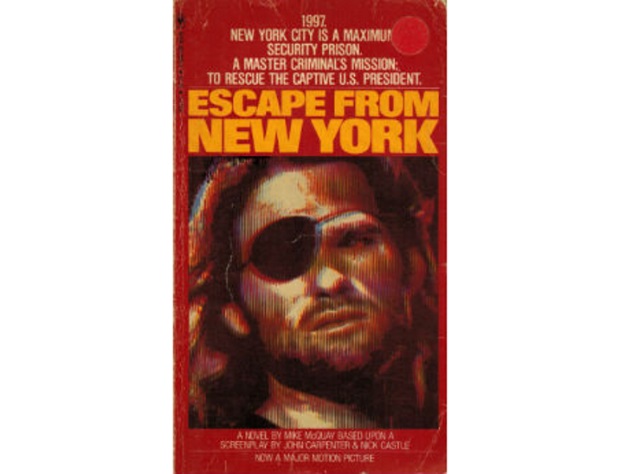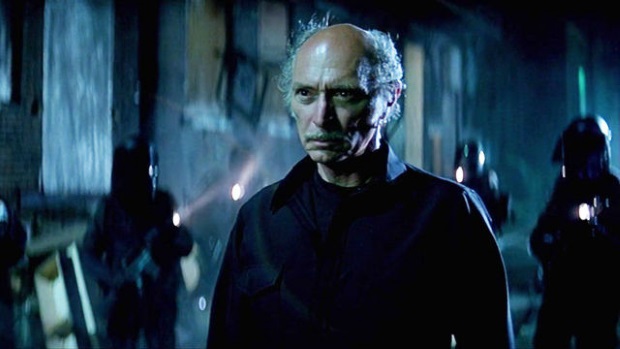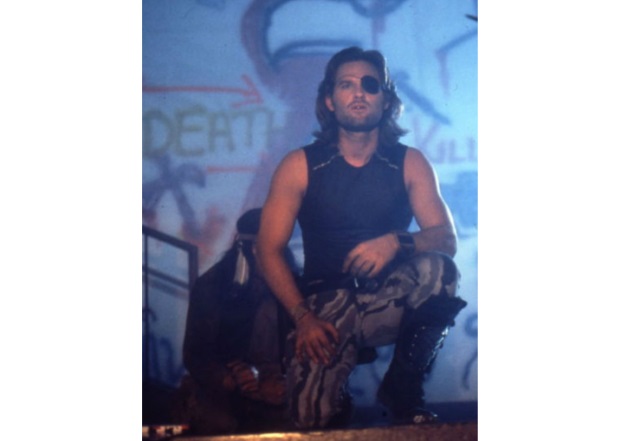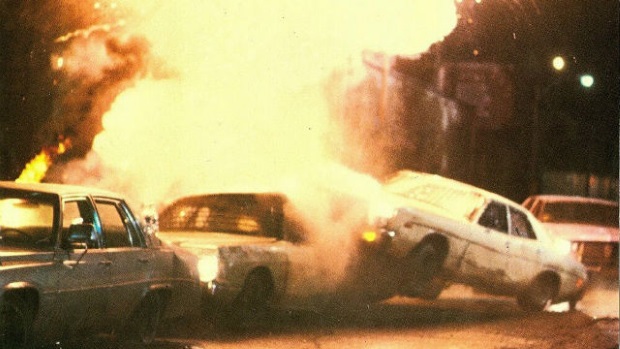What We Learned From the Escape From New York Novelization
John Carpenter's Escape From New York is a lean movie - and its novelization fills in some of its gaps...
Spoilers for Escape From New York lie ahead.
The great John Carpenter turned 70 recently, and it’s fair to say his cinematic legacy is assured at this stage. He’s the filmmaker behind genre classics Assault On Precinct 13, Halloween, The Thing, Big Trouble In Little China, They Live, and many others. He’s composed the music for the majority of his own work, in addition to being a writer, producer, editor and occasional actor. Carpenter appears to have retired from directing, choosing instead to focus on his own original music with 2015’s Lost Themes and its sequel album released the following year.
Some of Carpenter’s most beloved movies paired him with leading man Kurt Russell, with Escape From New York’s Snake Plissken being the most iconic. Snake is the definition of an anti-hero, and while he��s got a code of honour he’s not going out of his way to save lives either.
Carpenter has never been one to over explain or spell things out, preferring to let audiences fill in the blanks. In Escape From New York we never learn how Snake lost his eye, what happened to Fresno Bob or why everyone thinks Snake is dead. None of these questions matter really because they exist to add flavor to the world. Carpenter wrote Escape From New York in the early 1970’s, using Death Wish and Harry Harrison’s sci-fi novel Planet Of The Damned as inspiration. The latter also features a badass hero who has to go to the worst place ever – in this case, a war-torn planet – and race against a strict countdown to prevent disaster.

Escape From New York was translated into an enjoyably pulpy novel of its own by author Mike McQuay, who took Carpenter’s script and fleshed out the world a little more. It answers some unanswered questions and paints an even bleaker portrait of the future than the movie. The novelization also features various deleted scenes and subplots, including giving Hauk (Lee Van Cleef) a very personal reason for becoming warden of New York penitentiary.
“The name’s Plissken!”
Fans of Escape From New York are no doubt familiar with the deleted opening where Snake robs the Federal Reserve Depositary with a partner and gets arrested for his troubles. This sequence was cut after test audiences felt it took too long to get to the prison. It’s an interesting scene on its own terms, but the story doesn’t miss it. The novel also opens with this heist, and the opening chapters take some time to flesh out the world and Snake’s backstory.
Like the movie indicates, Snake was a war hero and patriot at one point until he was unknowingly recruited for a suicide mission dubbed ‘The Leningrad Ruse’. He and his squad flew their gulffire jets over the city in a spectacular battle that was set up to fail; this would allow the Russians to capture a double agent who would feed them bad intelligence and possibly turn the tide of World War III. Sadly even that was a failure since the Russians saw through the ploy immediately.
The only survivor of Snake’s unit was his friend Taylor, and it was on this mission Snake lost his eye; the Russians used nerve gas during the fight, and after his protective goggles cracked gas leaked in and ate away his eye. The damaged optical nerves cause Snake constant pain too, accounting for his bad moods.
The book also reveals Snake’s parents were killed by the trigger happy police force during a failed hostage rescue, and their life savings were seized by the government. His twin disgust over their deaths and the betrayal of his unit sets Plissken down the anti-hero road. At the outbreak of WWIII the countries involved agree not to deploy nukes, opting for nerve gas instead. The prolonged conflict renders most of America poisonous, with the surviving citizens slowly going insane due to the lingering effects of the gas. Even Snake and Hauk briefly experience minor side effects.
Snake’s war buddy Taylor is his accomplice during the opening robbery, and while Snake has the option to escape during the arrest he tries to save his wounded friend instead, who is eventually executed. The book then jumps to New York prison, revealing the city was the first target of the gas attacks, rendering most of its populace insane. With the country’s crumbling economy and rising crime it was soon decided to wall it off entirely and dump the undesirables inside.
“You gonna kill me now, Snake?”
It turns out Hauk is a disillusioned vet himself, and while he rarely visits the prison he made the trip to meet the legendary Snake, feeling the two have some kind of kinship. Hauk is actually riding in the same helicopter that blows the attempted escapees out of the water in the current opening, and while he gives the greenlight to kill them he forces the murderous pilot to issue a warning first. Hauk is generally disgusted by the police force of this dystopian future – dubbed ‘blackbellies’ – which comprises mainly of bloodthirsty war veterans.

Hauk has a personal reason for becoming warden of the prison: his son is somewhere inside. He took the job to look for him, and in the early days Hauk even went inside the necropolis to track him down. He’s essentially given up on that notion, but when Snake is prepping his gear Hauk asks him to keep a lookout, mentioning his son has HAUK tattooed on his hand. This pays off later when The Crazies chase Snake; remember when he blows the hand off a pursuing killer?
In the novel, Snake pauses a moment when he notices the severed appendage has HAUK tattooed on it. During their final scene together Hauk asks Plissken if he saw his son; Snake spares him the truth, stating his son is happy where he is and doesn’t need anything. While this McQuay addition adds some depth to Hauk, it feels stapled onto the story.
“You know what they did to Bob, huh?”
The book features bountiful deleted scenes from the script. One of the most notable is the unfriendly welcome Snake receives when his mission begins. The movie skips his walk down the stairs of the World Trade Centre and his first encounter with the Redskins gang, who are seen cooking a cat over a fire in the lobby. While Snake watches from the shadows a gang member sneaks behind and tries to strangle him. Snake breaks free and runs outside while the gang give chase before he turns to fire a flare gun that temporarily stuns them, buying him time to flee.

The book answers the question of birth control in the prison with a chapter that was likely added by McQuay. While Hauk ponders sending Snake into the prison, he’s taken to the Steri-Chamber, where new prisoners have a special box placed over their hips that castrates them. Snake is brought to the room by a crazed guard who takes perverse delight in the process, but when Snake ignores his taunts he pulls a gun on him, trying to goad Snake into attacking. Thankfully, Snake is spared this fate when he’s called to Hauk’s office. Snake gets the final word on the nasty screw – he breaks his nose on the way out.
When Snake enters the music theatre while tracking the President’s signal, he’s stopped by a muscular guard with a club. The guard wallops the sleeping doorman for failing to stop Snake sneaking in, but when he tries to get payment Snake flashes his rifle, scaring him off. The scene in the basement where he ignores the punks attacking a woman shows Snake is far from a hero, but in the original version the gang stopped when they notice him. The leader tries to attack with a knife, but Snake rifle butts him and keeps moving.
An extended car chase was snipped from the finale, where The Duke and his men hunt Snake as he makes a break for the wall. In the movie, it’s just The Duke (Isaac Hayes), but originally three more cars were involved. Snake manages to create a pileup, causing two to crash into one another, before smashing the third with his taxi.

There are other bits and pieces, from Hauk having to deal with a cowardly Secretary of State while he oversees the rescue to Fresno Bob’s fate being revealed – he was skinned alive by police after he and Snake were betrayed by Brain. Snake’s exhaustion plays into the story, with Hauk providing him with a chunk of crystal meth to provide an energy boost when he flags. Sadly he loses this after being captured by The Duke, and he’s so knackered from the gladiator battle, losing blood and the endless running his body eventually blocks out the pain.
The Escape From New York novelization is a fun read and works as a concise little pulp novel. McQuay’s prose makes the action more visceral, and his description of the cannibalistic, pus-covered Crazies is positively gag-inducing. The author also adds some intriguing concepts, and while he paints an especially grim future, he makes sure to pepper the story with black humour. His version of Snake is slightly more emotional too, though most fans would probably prefer not to know his tragic backstory. If you’re a fan of Escape From New York and want to revisit it from a new angle, give the novelization a try.